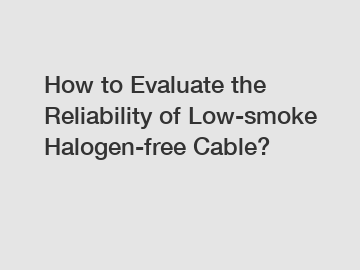How to Evaluate the Reliability of Low-smoke Halogen-free Cable?
How to Evaluate the Reliability of Low-smoke Halogen-free Cable?
Low-smoke halogen-free cables have become increasingly popular in various industries due to their improved safety and environmental attributes. As the demand for these cables grows, evaluating their reliability becomes crucial. Many factors contribute to the reliability of low-smoke halogen-free cables, including their performance under different conditions and their compliance with industry standards. In this article, we will explore how to assess the reliability of low-smoke halogen-free cables and the key points to consider in the evaluation process.
1. Performance Testing:

One crucial aspect of evaluating the reliability of low-smoke halogen-free cables is to assess their performance in different scenarios. Testing the cables under various conditions, such as high temperatures, extreme weather, and voltage fluctuations, can provide valuable insights into their reliability. It is essential to ensure that the cables maintain their mechanical and electrical properties without compromising their low-smoke and halogen-free characteristics.
2. Fire Performance:
Fire performance is another critical parameter to consider when evaluating the reliability of low-smoke halogen-free cables. These cables are designed to emit low smoke and minimal toxic gases during combustion, contributing to the safety of people and assets. Testing their fire performance, including flame spread, heat release, and smoke emissions, can demonstrate their ability to withstand fire incidents and prevent the spread of flames.
3. Compliance with Standards:
To ensure the reliability of low-smoke halogen-free cables, it is crucial to verify their compliance with relevant industry standards. Standards such as International Electrotechnical Commission (IEC) 60754, IEC 61034, and IEC 60332-3 establish guidelines for the assessment of cables' halogen content, smoke generation, and flame propagation. Manufacturers should provide documentation and test reports to validate the conformity of their cables with these standards.
4. Material Selection:
The choice of materials used in low-smoke halogen-free cables significantly impacts their reliability. While manufacturers may claim their cables to be low-smoke and halogen-free, it is essential to verify the composition and quality of the materials used. Materials should be selected based on their ability to withstand environmental factors, resist degradation over time, and meet stringent safety requirements.
5. Quality Control:
Implementing rigorous quality control measures throughout the manufacturing process is vital to ensure the reliability of low-smoke halogen-free cables. Quality control inspections, including visual checks, dimensional measurements, and electrical tests, help identify any defects or deviations from specifications. Adhering to an effective quality control system ensures the production of reliable cables that meet industry standards.
6. Real-life Applications:
Assessing the reliability of low-smoke halogen-free cables should also consider their performance in real-life applications. Feedback from users and case studies can provide valuable information about the durability and reliability of these cables in various industries. Understanding their performance in different environments and applications allows for a comprehensive evaluation of their reliability.
In conclusion, evaluating the reliability of low-smoke halogen-free cables requires a multi-faceted approach. Performance testing, fire performance assessment, compliance with industry standards, material selection, quality control, and real-life application analysis are all crucial points to consider. By thoroughly evaluating these factors, individuals and organizations can ensure they are using reliable low-smoke halogen-free cables that promote safety, environmental sustainability, and optimal performance in various applications. So, the next time you are considering the reliability of low-smoke halogen-free cables, keep these points in mind to make an informed decision.
If you are looking for more details, kindly visit electrical cables sizes, 450/750v welding cable, 120mm 4 Core Armoured SWA Cable.
165
0
0


Comments
All Comments (0)